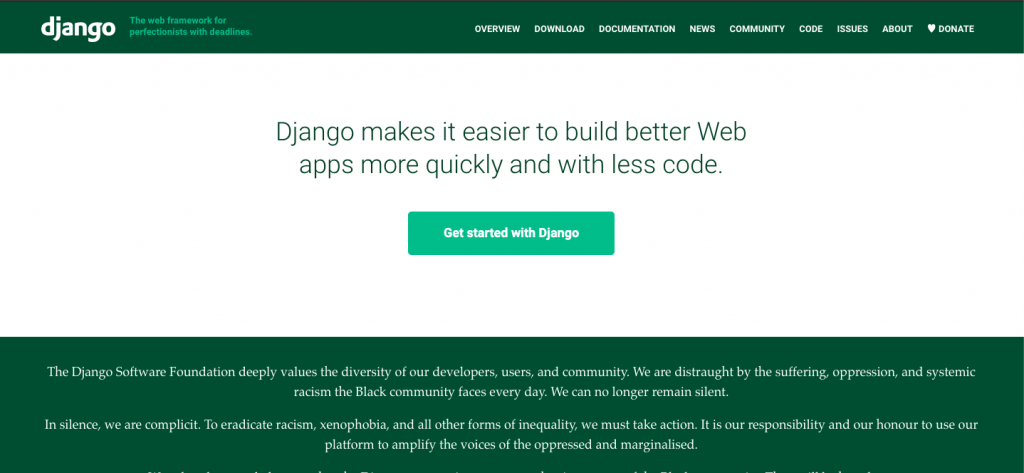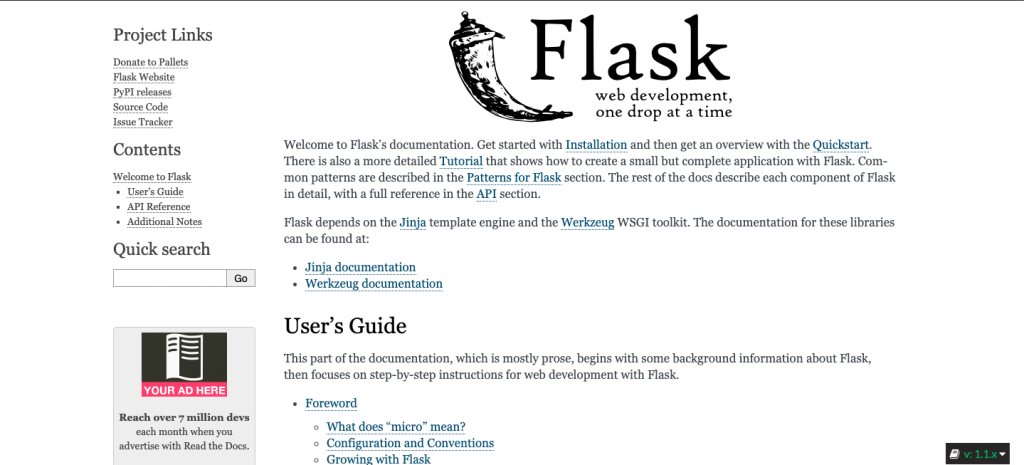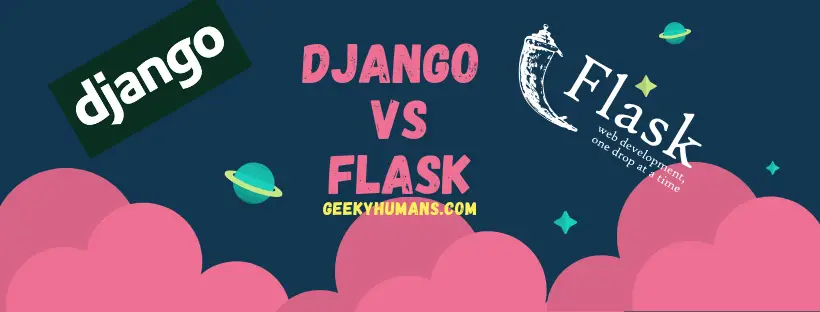Many Python-based web frameworks enable developers to create scalable applications quickly. From simple to complex websites, these frameworks can do it all. Out of the many popular options, Django and Flask are the most talked about – and mostly because both are similar in some ways and different in many other ways! That leads to a comparison between both, and while each of these web development frameworks has its unique features, there are many factors you should look at before choosing one for your applications.
Django is a full-stack web framework, whereas Flask is a lightweight, extensible framework. If one wants to dig more into coding and learn core concepts, Flask helps them understand how each component from the back-end works to get a simple web application up and running. Django follows lots of design patterns, and hence you learn and understand a lot of exciting concepts. Further, with both frameworks, there is a whole lot of community support and documentation, so if you ever run into any problems, the chances are that the problem has been already discussed and sorted out – something that makes your work easier.
Django is heavy-weight, whereas, you have to build everything on your own with Flask. Django has been around since the year 2005; Flask kept its foot in 2010 – about 5 years later. However, both are top frameworks in the world of Python as of today. Their growing popularity is evident, considering the number of questions people ask about both these frameworks in various tech forums.
You can work on any of the frameworks if you have a working knowledge of Python. For your convenience, we have given a basic overview of both Django and Flask so that you can appreciate the differences and usage of each in the best way.
What is Django?

Django is a free and open-source Python web development framework that follows the Model–Template–View (MTV) pattern. It was created in the fall of 2003 by Adrian Holovaty and Simon Willison. Django was developed to simplify the website development process. It focuses on reusable components, less code, and rapid development. It was influenced by several earlier frameworks including Zope and Plone and, in turn, has inspired lots of other frameworks that have come after it including Pyramid, CherryPy, Bottle, and Web2py.
Features of Django
Here are some important features of Django:-
- Offers Model – View – Controller (MVC) Architecture.
- Predefined libraries for imaging, graphics, scientific calculations, etc.
- Supports for multiple databases.
- Cross-platform operating system.
- Site optimization across specialized servers
- Support for front-end tools such as Ajax, jQuery, Pyjamas, etc.
- Supports multi-Language and multi-characters.
Advantages of Django
Here, are the pros/benefits of the Django framework:
- Django is easy to set up and run.
- It provides an easy to use interface for various administrative activities.
- It offers multilingual websites by using its built-in internationalization system.
- Django allows end-to-end application testing.
- Allows you to document your API with an HTML output.
- REST Framework has rich support for several authentication protocols.
- It is used for rate-limiting API requests from a single user.
- Helps you to define patterns for the URLs in your application.
- Offers built-in authentication system.
- Cache framework comes with multiple cache mechanisms.
- High-level framework for rapid web development.
- A complete stack of tools.
- Data modelled with Python classes.
Disadvantage of Django
Here, are cons/drawbacks of the Django framework:-
- It is a monolithic platform.
- High dependence on Django ORM. Broad Knowledge required.
- Fewer Design decisions and Components.
- Compatibility with the latest technologies
- A higher entry point for simple solutions
- The larger size of the code
- Too bloated for small projects
- Under-powered templating and ORM
- Templates failed silently
- Auto reload restarts the entire server
- High learning curve
- Documentations does not cover real-world scenarios
- Only allows you to handle a single request per time.
- Routing requires some knowledge of regular expressions
- Internal subcomponents coupling
- You can deploy components together, which can create confusion.
What is Flask?

Flask is a light-weight framework categorized as a micro framework. Flask comes with some standard functionalities and allows developers to add any number of libraries or plugins for an extension. If you have a simple, innovative use case to be added to an existing application, Flask should be your choice as it provides flexibility. Flask comes with a small set of easy-to-understand and learn API, and the documentation is excellent. If you are new to Python, start your web development with Flask, so that you can get the feel of backend and frontend both as well as understand the core concepts well.
Features of Flask
Here are some important features of Flask:-
- Integrated support for unit testing.
- RESTful request dispatching.
- Uses a Ninja2 template engine.
- It is based on Werkzeug toolkit.
- Support for secure cookies (client-side sessions).
- Extensive documentation.
- Google app engine compatibility.
- APIs are nicely shaped and coherent
- Easily deployable in production
Advantages of Flask
Here are some pros/benefits of using Flask:-
- Higher compatibility with latest technologies
- Technical experimentation
- Easier to use for simple cases
- Codebase size is relatively smaller
- High scalability for simple applications,
- Easy to build a quick prototype
- Routing URL is easy
- Easy to develop and maintain applications
- Database integration is easy
- The small core and easily extensible
- Minimal yet powerful platform
- Lots of resources available online especially on GitHub
Disadvantage of Flask
- Here are some cons/drawback of Flask:-
- Slower MVP development in most cases,
- Higher maintenance costs for more complex systems
- Complicated maintenance for larger implementations.
- Async may be a little problem
- Lack of database and ORM
- Setting up a large project requires some previous knowledge of the framework
- Offers limited support and smaller community compared to Django
Comparison b/w Flask and Django on various basis
Type of Web Framework
As mentioned earlier, Django is a full-stack Python web framework. Also, it is developed based on a batteries-included approach. The batteries included in Django make it easier for Django developers to accomplish common web development tasks such as user authentication, URL routing, and database schema migration. Moreover, Django accelerates custom web application development by providing a built-in template engine, ORM system, and bootstrapping tool. On the other hand, Flask is popular for its simplicity, lightweight, and minimalist web framework. It lacks some of the built-in features offered by Django. But it helps developers to keep the core of a web application simple and extensible.
Functional Admin Interface
Unlike Flask, Django makes it easier for users to handle common project administration tasks by offering a ready-to-use admin framework. It further generates the functional admin module automatically based on models of the project. The developers even have the option to customize the admin interface to meet specific business needs. They can even take the merit of the admin interface to ease website content administration and user management. The functional admin UI makes Django stand out in the crowd.
Template Engine
As mentioned earlier, Flask is created based on the Jinja2 template engine. As a rich-featured template engine for Python, Jinja2 is also inspired by Django’s template system. It enables creators to accelerate the development of dynamic web applications by taking advantage of an integrated sandboxed execution environment and writing templates in an expressive language. Django comes with a built-in template engine that enables creators to define a web application’s user-facing layer without putting in extra time and effort. It even offers developers to accelerate custom user interface development by writing templates in Django template language (DTL).
Built-in Bootstrapping Tool
Django is introduced with a built-in bootstrapping tool – Django-admin. Django-admin enables creators to start developing web applications without any external input. Django even permits developers to divide a single project into a number of applications. The developers can use Django-admin to create new applications within the project. They can further use the applications to add functionality to web applications based on varied business needs.
Project Layout
Flask needs developers to each project as a single application. But the developers have the option to add various models and views to the same application. On the other hand, Django permits developers to divide a project into multiple applications. Hence, it becomes easier for creators to write individual applications, and add functionality to the web application by integrating the applications into the project. The small applications further allow developers to extend and maintain the web applications written in Python.
Database Support
Django offers developers to take advantage of a robust ORM system. The developers can use the ORM system to work with widely used databases such as MySQL, Oracle, SQLite, and PostgreSQL. Moreover, the ORM system enables developers to perform common database operations without writing lengthy SQL queries. Unlike Django, Flask does not offer a built-in ORM system. It needs developers to work with databases and perform database operations through SQLAlchemy. The developers of Python can work with databases by using SQLAlchemy as a SQL toolkit and ORM system for Python. Moreover, they can perform common database queries by writing and executing SQL queries.
Flexibility
The batteries included in Django help developers to build various web applications without using third-party tools and libraries. But the developers lack any option to make changes to the modules offered by Django. Hence, developers have to create web applications by availing the built-in features provided by the web framework. Whereas, Flask is a micro but extensible web framework. It enables developers to create web applications more flexibly by using several widely popular web development tools and libraries. Many beginners even find it easier to understand and learn Flask than Django due to its simple and customizable architecture.
Usage and Use Cases
Both Flask and Django are now being used by several high-traffic websites. But the usage statistics posted on various websites depict that Django is more widely used than Flask. One can find some of the best websites developed using Django here. The developers can take advantage of the robust features offered by Django to develop and deploy complex web applications rapidly. At the same time, one can use Flask to accelerate the development of simple websites that use static content. However, the developers still have the option to extend and customize Flask according to precise project needs.
Key Differences between Flask and Django
Flask
- Flask was created in 2007.
- Python web framework built for rapid development.
- Flask is a WSGI framework.
- Flask provides support for API.
- Support Visual Debug.
- Flask allows you to use multiple types of databases.
- It has no default support for forms, but you can use WTForms to fill the gap.
- Flask does not offer dynamic HTML pages.
- The request based object is imported from the flask module, which is a global variable in Flask.
- Flask is a much younger platform compared to Django.
- Flask offers a diversified working style.
- It supports an extension which could be implemented in the framework.
- The structure of the project layout for the Flask web framework is random.
- Flask web framework uses a Ninja2 template design.
- URL dispatcher of the Flask web framework is a RESTful request.
- Flask does not offer a built-in bootstrapping tool.
- It is a good choice if you want a lightweight codebase.
- Flask framework is suitable for a single application.
- It Web Framework doesn’t offer support for third-party applications.
- Git hub stars 48.8 K
- Best features of the flask are it is lightweight, open-source, and offer minimal coding for developing an application.
- Famous companies using Flask are: Netflix, Reddit, Lyft, MIT
Django
- Django was created in 2005
- Python web framework built for easy and simple projects.
- Django is a Full Stack Web Framework.
- Django does not have any support for API.
- No support for Visual Debug.
- Django does not offer multiple types of databases.
- It comes Form with which can be integrated with the ORM and the admin site.
- Django offers dynamic HTML pages.
- All views are set as an individual parameter in the Django.
- Django is a very mature framework.
- It offers a Monolithic working style.
- Django has its own module library. So, it stores several prewritten codes.
- The structure of the project layout for the Django is conventional.
- Django web framework helps you to utilizes the View web templating system.
- URL dispatcher of this Django framework is based on controller-regex.
- Django-admin enables developers to start building web applications without any external input.
- The best feature of Django is Robust documentation.
- Django framework allows developers to divide a project into multiple page application.
- Django Web Framework supports a large number of third-party applications.
- Git hub stars 47.1 K
- The best features of Django are Rapid development, Open source, Great Community, Easy to learn.
- Famous companies using Django are Instagram, Coursera, Udemy.
Conclusion
Many developers have one common question – which of the framework is better? You might have got a fair idea by now of how each framework works and what are the best ways to use each of them. That said, there are many high-traffic websites built on Flask as well, which perform well and are comparable with those built on Django. Quite a few basic concepts are the same in both Django and Flask, but Django is complicated and vast and requires a deep learning curve, so if one wants to get the ‘feel’ of a web framework, start with Flask and then move on to Django for more sophisticated applications. Or you can master one and then switch when your job needs you to, rather than having to learn everything at once.
With Flask, one can start with some necessary programming skills, but Django needs some prior homework for you to write even a Hello World program. However, as your project structure increases, you find that adding new functionalities is more overwhelming in Flask, whereas Django would seem like a breeze. Start your Django journey with this beautiful tutorial.
In conclusion, both Django and Flask are fun to work with, with both giving you a lot of new stuff to learn. Build a project with the help of this tutorial to start your web development journey with Flask.


